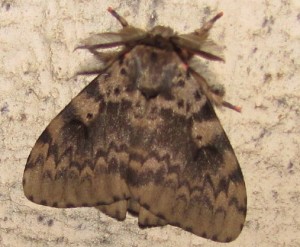
The gypsy moth population in Michigan decreased dramatically in 2011. Photo: satshot2010 (flickr)
By Yanjie Wang
Eating leaves of hardwood trees, the gypsy moth is known as the most devastating insect in the United States.
But a recent report about major forest insect and disease conditions by the U.S. Forest Service said the population of gypsy moths decreased dramatically in Michigan last year.
According to the report in 2011, 1,047 acres of forest were affected by gypsy moths, an exotic pest from Asia, while 941,981 acres in the state were affected in 2010.
Brenda Owen, executive director of the Michigan Association of Timbermen in Newberry, said a lower population contributes to a healthier forest.
She also said without efforts to reduce the population, the forest product industry would also be hurt.
“The gypsy moth is a big defoliator,” said Len Scuffham, timber and silviculture program manager of the Ottawa National Forest in Ironwood.
Although Scuffham said he doesn’t see many gypsy moths in his nearly 1 million-acre national forest in the western Upper Peninsula, “they do more damage than native insects, so trees don’t have a natural defense against it.”
Ronald Murray, a forest health supervisor at the Department of Natural Resources (DNR), said Michigan has had severe defoliation by gypsy moths in the past.
Murray said DNR has been making efforts to lower the population.
A disease called entomophaga maimaiga has contributed to the decline, he said.
“It is a disease that kind of naturally exists in the population,” he said. “The disease attacks larvae before they can grow into adults and it destroys the gypsy moth from inside.”
For several years, Murray said DNR has surveyed places where defoliation happened, found those spots and evaluated the population level.
“If the population is high enough, we will consider spreading the disease in the woods. Caterpillar will eat the leaves and become sick,” Murray said. “But it has not been done for years.”
DNR has used aircraft to spread the disease, Murray said. “The disease would blow in the wind, and when the moths fly, they could get caught by wind.”
In addition to human efforts to lower the population, Murray said wet, cold weather could be another factor compared to dry, sunny weather, which gypsy moths prefer.
However, Murray said cold weather does not make much difference in the Lower Peninsula.
Matthew Sands, a forester with the U.S. Forest Service in Baldwin, said while cold weather could kill the eggs of gypsy moths, a wetter spring and summer could also help the disease to kill it.
Bob Heyd, a DNR forest health specialist in Marquette, said the department didn’t map any gypsy moths this year because of the wet spring.
He also said when the population peaked in 2010, caterpillars ate leaves too early in their development stage, which resulted in a lack of food for them.
The Forest Service report said beech bark disease, spruce budworm and emerald ash borer continued to spread in Michigan last year.
